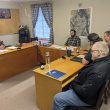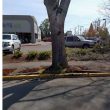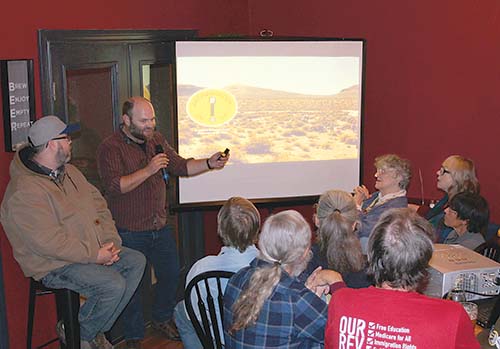Archaeologist JD Lancaster’s dream is to someday find evidence of the earliest people in the western half of the Great Basin.
This evidence will likely be human feces that is thousands of years old.
He suspects this waste, called coprolites, will be found deep inside a cave, and it will be a messy business.
“It’s so dry inside of these caves that these piles of poop have preserved for quite a long time,” Lancaster said. “It tends to be a dirty, dusty, nasty business, but what you find is these biological remains, and then tools that tell us about who those people were, and that there were in fact people there.”
Lancaster moved to Lebanon with his wife, Katy, who’s also an archaeologist, four years ago to earn his Ph.D. at Oregon State University.
Meanwhile, he is growing his passion by identifying archaeologically significant sites in Oregon, and educating the community through events, such as the inaugural Archaeology on Tap, held at Barsideus Brewing earlier this month.
Lancaster recently founded a nonprofit called Northwestern Archaeological Conservancy, whose mission is to protect local cultural resources through research, preservation and education.
Archaeologically significant sites are protected under the National Historic Preservation Act, so any time there is development on federal, state or private lands, there needs to be a check on those properties to see if there is anything that would be eligible for protection, he said.
“What we do in part of our mission is to provide those services to the federal government and to state governments,” he said.
NAC recently completed its first major field project in Lakeview in collaboration with the Oregon Department of Forestry, Natural Resources Conservation Service, several private landowners and a private nonprofit organization that’s dedicated to preserving watersheds, he said.
Another project coming up will be in the Klamath Falls Conservation District.
Juniper trees have been dominating the area since the 1980s, and they are using up the landscape’s water at an unprecedented rate, Lancaster said. The government is working on thinning out these trees to improve the watershed and health of the forest, but they first need to be sure this work doesn’t destroy any archaeologically significant sites.
NAC crew members, interns and volunteers survey the land by lining up about 60 feet apart from each other and starting the walk across 2,000 acres of land earmarked for cutting. They look for can dumps and other pre-1940s waste sites.
Nicole Waite, a field assistant with NAC, said the work at Lakeview – which lasted five to 14 days at a time – was exhausting and gave her blisters, but she fully appreciated having the opportunity to find “cool artifacts” and work with a team of people she loves.
The team camped near their work site, woke early every morning, “slugged” their coffee, packed up, and headed out for the day’s walk, she said.
“It doesn’t sound too exciting, and I suppose it isn’t to some people,” Waite said. “But when we’re out there, that’s where we can find amazing things. Or see wildlife. Or we make up silly songs about the artifacts we’re finding.”
When archaeological evidence was found, they documented what was there, took photographs, recorded the location, and then moved on to find the next site, Lancaster said.
In the Lakeview area, the NAC crew found a lot of lithic scatters, or lithic workshops, which are spots where early humans sat down and made tools.
“They were making arrowheads, scrapers, knives – anything they could use to hunt or produce food goods and other things like that,” Lancaster said.
To an untrained eye, these sites just look like a bunch of broken rocks on the ground, but Lancaster can recognize the flakes and “garbage” left behind by those tool makers.
Because NAC is only performing pedestrian surveys on these current projects, they only document what’s found on the surface, he said.
If his clients were doing ground-disturbing projects, such as an excavation for a big lake or reservoir, they would need to do sub-surface testing to see whether there’s anything beneath the ground.
After NAC documents its finds, members make recommendations on how the government should proceed.
While doing this kind of field work is important to NAC, it’s only a fragment of the larger picture for Lancaster.
“Part of our whole mission is to bring awareness to what’s going on in these areas,” he said.
They want to create avenues that will educate the community and invite them to participate.
“The heart of what we are doing is one hundred percent in the right place,” Waite said. “The focus is not only on getting the work done and doing what we want to do, but to
make archaeology more accessible to the general public; we want to engage and educate people, and to encourage people to get involved in any way that they can.”
Part of the education aspect is to host events that connect the public with researchers involved in local archaeology, such as in Archeology on Tap. Similar to “Science Pubs” or “Science Distilled,” Archaeology on Tap allows researchers to present projects they’re working on, and give the community an opportunity to discuss in a casual setting what is being discovered in Oregon.
Three researchers – Cayla Hill, Molly Kirkpatrick and Scott Thomas – presented about their work in St.
Paul, Tahkenitch Landing, and eastern Oregon.
“The whole idea is to make science public,” Lancaster said.
He was surprised by the turnout, which he estimated at around 40 people. The bar was filled to capacity.
Mark Casebier, a biologist from Sweet Home, said he heard about the event a month prior, and had been “chomping at the bit” to attend.
Self-proclaimed “nerd” Dennis Turner, along with his wife Michelle Dugi, who live in the Lebanon-Waterloo area, thought it was a great opportunity to check out the new Barsideus Brewing while also learning how the area has developed over time.
The venue was a bit noisy, but it didn’t stop Linda Ziedrich and Cindy Cole, both of Lebanon, from enjoying the lectures. Ziedrich has been to Science Pubs in Portland, and she said the idea of having something similar in Lebanon is a wonderful idea.
“We need more things to do in the evening besides drink beer; intellectual activities are great,” Ziedrich said.
Cole said she’s fascinated with Oregon archaeology and has attended several lectures on the topic.
“Where else do you get to hear about what’s happening with the young folks in this field?” she said.
“I think it’s kind of neat to see how many people showed up, how much of interest there is in it.”
Lancaster attributed the large turnout to his belief that people are interested in heritage.
“We all have this human heritage. I think deep down inside, that’s something people really love, and I think when you bring it to people, they really tap into it,” he said.
Waite agrees that most people want to know about local history and prehistory.
“Making it accessible inspires a greater connection within people in the community,” she said.
Although most archaeological work is done in eastern Oregon where land is public, rather than private and developed, Lancaster admits he’s heard stories of local farmers discing their field and pulling up Native American artifacts.
“All around us are these amazing archaeological sites; ranchers and farmers come across them all the time,” he said. “There’s large villages that were located all along the streams and the river systems around here.”
Stone tools such as arrowheads, flaked butchering tools, ground stone and food processing tools are really common around here, he noted.
Another important purpose for NAC is to build a sustainable model that might guarantee the continual preservation of archaeological sites.
“One of the things that I’ve seen over the past couple years, being involved in the industry, is that funding from the federal level for the protection of these sites and these resources has been decreasing at a pretty fast rate,” he said.
Lancaster fears if that trend continues, the type of work he does will die out.
“That might be okay for some people, but back in the 1960s we all collectively decided that these things are important to us, and enacted that in the National Historic
Preservation Act,” he said.
Lancaster envisions local nonprofits and members of the community, as well as graduating archaeology students, as stewards to the preservation of these sites in partnership with universities and government.
“We’re trying to switch this model from something that’s a government- based activity – that the government preserves these things for us – to a community and grassroots
level instead,” he said.
“In my mind, cultural heritage is one of these things that we all share as humans. If we want to continue to be surrounded by these things, we need to work to protect them, and these are some of the things we need to do to do that.”
Lancaster figured out his passion for archaeology – or, more specific to him, geo-archaeology – while he was a finish carpenter. He’d been interested in history since childhood, and also found he enjoyed physical work outdoors.
“Once I realized archaeology was a combination of those two things – history, working outdoors, working with your hands, I was pretty much hooked at that point,” he said.
Geo-archaeologists use geology to understand the landscapes humans lived in and why they were located in particular locations.
Lancaster is amazed when he can learn about the landscape’s past just by looking at its physical objects in cut banks, and even more so when he finds evidence of human interaction with that environment, he said.
“It’s this intimate connection between the environment and humans in this time in the past where you can’t even really imagine what the landscape was like; it’s completely different that far back in the past,” he said. “It’s really exciting to find that stuff.”
Lancaster expects to finish his Ph.D. in a couple of years, and is working on his dissertation
through field work in eastern Oregon between Burns and John Day in the Silvies Valley.
For more information, or to find out when the next Archaeology on Tap will be, visit www.nac.ngo.





